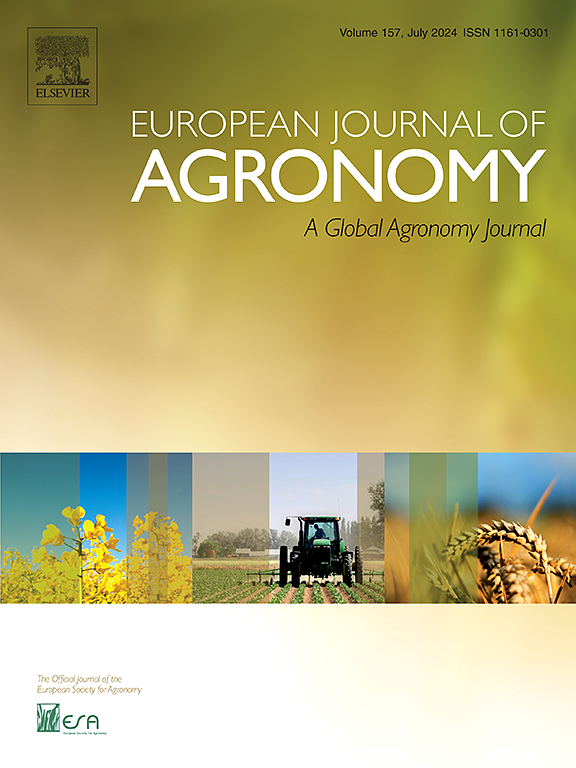氧化酶和水解酶在通过土壤管理实践加强碳固存中的作用:一项跨不同生态系统的全球元分析
IF 5.5
1区 农林科学
Q1 AGRONOMY
引用次数: 0
摘要
土壤管理措施(SMPs)通过调节潜在酶(PE)活性来提高土壤有机碳(SOC)储量和/或组分。研究PE活动和有机碳成分,以及它们在SMPs响应中的相互关系,可以提高我们对PE活动如何调节有机碳矿化的理解。因此,我们基于125项同行评议的研究进行了荟萃分析,以评估SMPs对PE活动和SOC成分的影响。结果表明,SMPs显著提高了土壤有机碳含量、微生物生物量碳(MBC)、溶解有机碳(DOC)和β-葡萄糖苷酶(BG)、α-葡萄糖苷酶(AG)、纤维素生物水解酶(CBH)、β-木糖糖苷酶(XYL)和过氧化物酶(PER)的活性,分别提高了22.96 %、35.88%、22.26 %、35.62 %、31.06 %、26.76 %、29.94 %和8.92 %。(1) SOC与BG/CBH活性呈显著正相关;(2) MBC和BG/AG/CBH/XYL/PER活性;(3) DOC和BG/AG/CBH/苯酚氧化酶(PO)活性。这些发现表明SMPs通过水解酶和/或氧化酶调节SOC成分。土壤有机碳水平受气候条件、初始有机碳含量和土壤pH的影响。smp条件下,当年平均温度(MAT)超过20℃、初始pH >; 7.7和初始SOC <; 10 g kg−1时,土壤有机碳积累量增加。研究结果表明,SMPs总体上提高了土壤有机碳储量,但提高的程度取决于生态系统类型、初始土壤性质、外源有机物质类型以及处理方法在为微生物活动和PE生产提供能量和基质方面的有效性。总体而言,smp提高了土壤有机碳储量及其组分,为优化施肥组合和外源有机物质在不同生态系统中的应用提供了科学依据。本文章由计算机程序翻译,如有差异,请以英文原文为准。
The role of oxidases and hydrolases in enhancing carbon sequestration through soil management practices: A global meta-analysis across diverse ecosystems
Soil management practices (SMPs) enhance soil organic carbon (SOC) storage and/or components by regulating potential enzyme (PE) activities. Investigating PE activities and SOC components, along with their interrelationships in response to SMPs, can improve our understanding of how PE activities regulate SOC mineralization. Therefore, we conducted a meta-analysis based on 125 peer-reviewed studies to assess the effects of SMPs on PE activities and SOC components. Our results demonstrated that SMPs significantly increased SOC content, microbial biomass carbon (MBC), dissolved organic carbon (DOC), and the activities of β-glucosidase (BG), α-glucosidase (AG), cellobiohydrolase (CBH), β-xylosidase (XYL) and peroxidase (PER) by 22.96 %, 35.88 %, 22.26 %, 35.62 %, 31.06 %, 26.76 %, 29.94 % and 8.92 %, respectively. Significant positive correlations were observed between: (1) SOC and BG/CBH activities; (2) MBC and BG/AG/CBH/XYL/PER activities; and (3) DOC and BG/AG/CBH/phenol oxidase (PO) activities. These findings suggest that SMPs regulate SOC components through hydrolases and/or oxidases. Moreover, SOC levels were influenced by climatic conditions, initial SOC content, and soil pH. Higher SOC accumulation was observed when mean annual temperature (MAT) exceeded 20℃, initial pH > 7.7, and initial SOC < 10 g kg−1 under SMPs. Our findings indicate that SMPs generally improve SOC storage, but the extent of enhancement depends on ecosystem types, initial soil properties, types of exogenous organic materials, and the effectiveness of treatment methods in providing energy and substrates for microbial activity and PE production. Overall, SMPs enhance SOC storage and its components, providing a scientific basis for optimizing fertilizer combinations and the application of exogenous organic materials in diverse ecosystems.
求助全文
通过发布文献求助,成功后即可免费获取论文全文。
去求助
来源期刊

European Journal of Agronomy
农林科学-农艺学
CiteScore
8.30
自引率
7.70%
发文量
187
审稿时长
4.5 months
期刊介绍:
The European Journal of Agronomy, the official journal of the European Society for Agronomy, publishes original research papers reporting experimental and theoretical contributions to field-based agronomy and crop science. The journal will consider research at the field level for agricultural, horticultural and tree crops, that uses comprehensive and explanatory approaches. The EJA covers the following topics:
crop physiology
crop production and management including irrigation, fertilization and soil management
agroclimatology and modelling
plant-soil relationships
crop quality and post-harvest physiology
farming and cropping systems
agroecosystems and the environment
crop-weed interactions and management
organic farming
horticultural crops
papers from the European Society for Agronomy bi-annual meetings
In determining the suitability of submitted articles for publication, particular scrutiny is placed on the degree of novelty and significance of the research and the extent to which it adds to existing knowledge in agronomy.
 求助内容:
求助内容: 应助结果提醒方式:
应助结果提醒方式:


